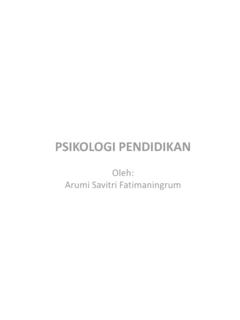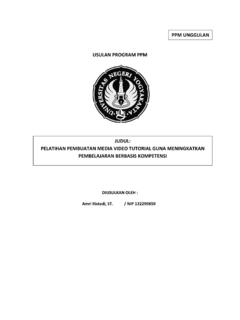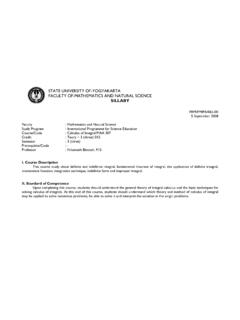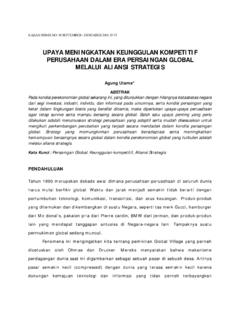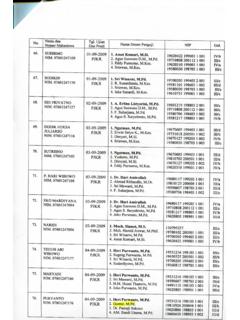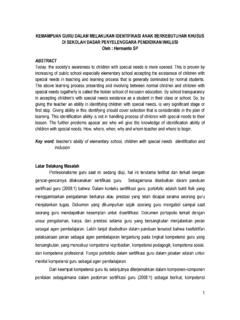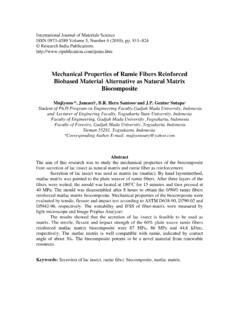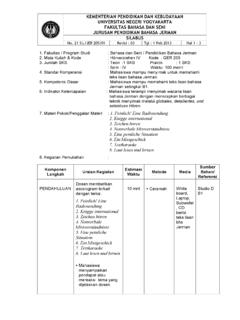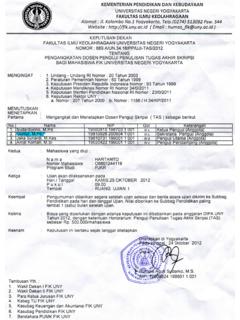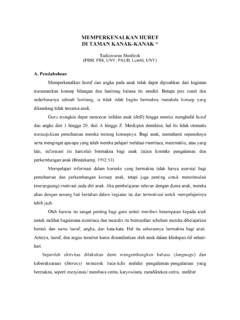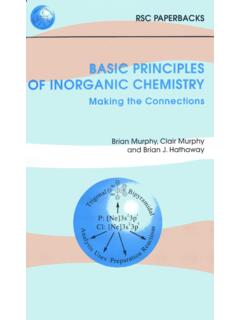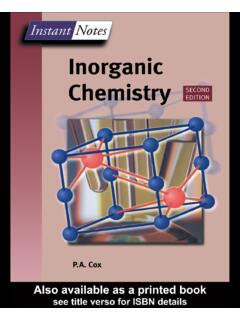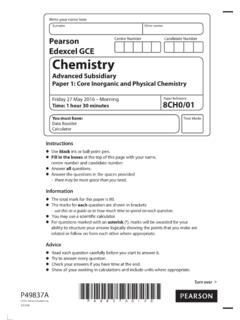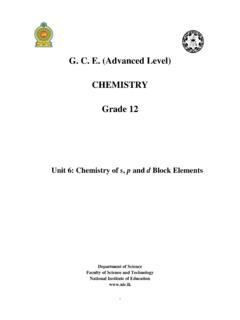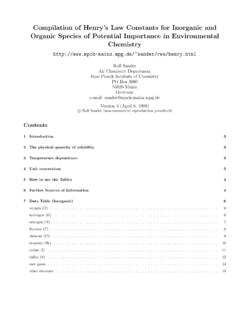Transcription of Laboratory manual Of PRACTICAL INORGANIC II CHEMISTRY
1 Laboratory manual of PRACTICAL INORGANIC II CHEMISTRY Laboratory manual Of PRACTICAL INORGANIC II CHEMISTRY HCP CCP By: M. Pranjoto Utomo DEPARTMENT OF CHEMISTRY EDUCATION FACULTY OF MATHEMATICS AND NATURAL SCIENCES YOGYAKARTA STATE UNIVERSITY 2011 1 Laboratory manual of PRACTICAL INORGANIC II CHEMISTRY PREFACE The manual of INORGANIC II Laboratory work is a Laboratory guideline to the students of CHEMISTRY Department, Mathematics and Natural Sciences Faculty, Yogyakarta State University, in INORGANIC II course. According to the material of INORGANIC II course, the Laboratory activities are directed to understand the model of ionic compound close packing, reduction-oxidation reaction of several metals, improve the double salt preparation and re-crystallization skills as the basic for advance Laboratory activities.
2 Because of the restrictiveness of equipment and chemicals, some of PRACTICAL subject can not be done. Of course, this Laboratory manual does not support optimally to the INORGANIC II course. The English edition of INORGANIC II Laboratory work manual is the same in contents with Indonesian edition. Revision done by simplifies the language and the direction also separates the manual and the worksheet. It is hoped, this manual may be a guideline to improve student Laboratory skill especially in INORGANIC Laboratory work. Yogyakarta, August 2011 M. Pranjoto Utomo 2 Laboratory manual of PRACTICAL INORGANIC II CHEMISTRY RULES OF INORGANIC II Laboratory WORK A.
3 Laboratory work presence 1. Every student must come on time and fill the presence book. 2. Students, who come over than 15 minutes from the Laboratory work schedule, may follow the Laboratory work if only permitted by the lecturer. 3. All students must participate in every Laboratory work activity. 4. The permitted PRACTICAL tags are twice. B. Carrying Out of Laboratory Work 1. Laboratory work of INORGANIC II is group Laboratory activity. Each group consists of 4 students. Each group member has individual responsibility to the result of Laboratory work (report). 2. Every student has to wear white- Laboratory coat, bring a napkin and dropper pipette. C. Laboratory Work Report 1. Every student must compose individual report on the student worksheet.
4 2. Student worksheet must be collected to assistant or lecturer at the same day with Laboratory work day. 3 Laboratory manual of PRACTICAL INORGANIC II CHEMISTRY Laboratory PRECAUTIONS A. Inside the Laboratory 1. Do not eat, drink beverages or chew gum in the Laboratory . Do not use Laboratory glassware as containers for food or beverages 2. Wear safety goggles and aprons 3. Always keep the working area clean and orderly 4. Know the locations and operating procedures of all safety equipment. 5. Notify the instructor immediately of any unsafe condition you observe B. Handling Chemicals 1. All chemicals in the Laboratory are to be considered dangerous. Do not touch, taste or smell any chemical unless specifically instructed to do so 2.
5 Check the label on chemical bottles twice before removing any of the contents. 3. Never return unused chemicals to their original containers. 4. Acid must be handled with extreme care. ALWAYS ADD ACID SLOWLY TO WATER. 5. Handle flammable hazardous liquids over a pan to contain spills. Never dispense flammable liquids anywhere near an open flame or source of heat. C. Handling glassware and Equipment 1. Always lubricate glassware (tubing, thistle tubes, thermometers, etc.) before attempting to insert it in a stopper. 2. When removing an electrical plug from its socket, grasp the plug, not the electrical cord. Keep your hands dry when working with electricity. 3. Do not immerse hot glassware in cold water, it may shatter.
6 4. Report damage electrical equipment immediately. D. Heating Substances 1. TURN OFF THE GAS AT GAS OUTLET VALVE after using. 2. Never leave a lit burner unattended. Never leave anything that is being heated or is visibly reacting unattended. 3. Use tongs or heat-protective gloves when holding or touching heated apparatus. 4 Laboratory manual of PRACTICAL INORGANIC II CHEMISTRY Laboratory EQUIPMENTS Gas collecting tube Measuring pipette Stirring rod Thermometer Glass-stoppered burette Volumetric flask funnel Graduated cylinder Test tube Test tube rack Spot plate s-shaped test tube rack Forceps Dropper pipette spatula Triangular file Erlenmeyer flask Plastic wash bottle Beaker Gas-collecting bottle 5 Laboratory manual of PRACTICAL INORGANIC II CHEMISTRY Test tube brush Pinch clamp Test tube holder Watch glass Evaporating dish Crucible and cover Rubber stoppers Pneumatic trough Safety goggles Crucible tongs Clay triangle Wire gauze Utility clamp Iron ring Burette clamp Wing tip Burner Ring stand 6 Laboratory manual of
7 PRACTICAL INORGANIC II CHEMISTRY CONTENTS Page PREFACE .. i RULES OF INORGANIC II Laboratory WORK .. ii Laboratory PRECAUTIONS .. iii Laboratory EQUIPMENTS .. iv CONTENTS .. v EXPERIMENT 1. CLOSE PACKING GEOMETRY IN SOLID .. 1 EXPERIMENT 2. QUALITATIVE INORGANIC REACTION .. 10 EXPERIMENT 3. REDUCTION-OXIDATION REACTION .. 12 EXPERIMENT 4. REDUCTION-OXIDATION REACTION, THE INFLUENCES OF ACID AND BASE TO METALS .. 15 EXPERIMENT 5. ELECTROCHEMISTRY CELL AND ELECTRODE POTENTIAL.
8 18 EXPERIMENT 6. CORROSION OF METAL (1) .. 20 EXPERIMENT 7. CORROSION OF METAL (2) .. 23 EXPERIMENT 8. CORROSION OF METAL (3) .. 24 EXPERIMENT 9. PREPARATION OF POTASSIUM-CHROMIUM ALUM, KCr(SO4)2 12H2O .. 26 EXPERIMENT10. PREPARATION OF POTASSIUM-ALUMINUM ALUM, KAl(SO4)2 12H2O .. 28 EXPERIMENT 11. PREPARATION OF COORDINATION COMPOUND, [Ni(NH3)6]I2 .. 30 EXPERIMENT 12. PURIFICATION OF KITCHEN SALT BY RE-CRYSTALLIZATION METHOD .. 32 REFERENCES 34 7 Laboratory manual of PRACTICAL INORGANIC II CHEMISTRY EXPERIMENT 1 CLOSE PACKING GEOMETRY IN SOLID Purpose The main purpose of this activity is to study close packing geometry to illustrate the structure of ionic solid. Introduction Ionic solid can be viewed as a close packing of metal atoms.
9 The arrangement of atoms, molecules, or ions in a regularly and repeatedly pattern is known as a lattice space. The arrangement s nature is determined by three factors: 1) relative shape and size of atom, molecule or ion 2) nature and relative strength of chemical bonding 3) thermal energy of the system Two applied models of the arrangement are hole filling model (balls represent atoms or ions that are packed close one to others) and ball and stick expanding model, where the balls are separated by the stick connectors. In ball and stick crystal structure model, stick connectors represent covalent bonds (such as bonds in diamond) or ionic bonds (such as bonds in NaCl). On the other hand, stick connector illustrate crystal lattice of a solid.
10 In this activity, you have to arrange the balls, observe and fill the observation data on your work sheet to understand close packing geometry in solid. Materials ping-pong balls (at least contain of two colors) marbles buckshot electrical glue gun Ball Packing Efficiency Use amount of ping-pong and other smaller balls to arrange various arrangement patterns and to complete the following tasks. 1. Arrange the balls in side-by-side arrangement (Figure 1a) and in closest arrangement (Figure 1b). 8 Laboratory manual of PRACTICAL INORGANIC II CHEMISTRY Figure Packing models of (a) side-by-side layer, (b) hexagon layer, (c) simple cubic layer, (d) body centered cubic Determine the maximum amount of balls that can touch another one ball (center- ball) in the same layer for each arrangement.
